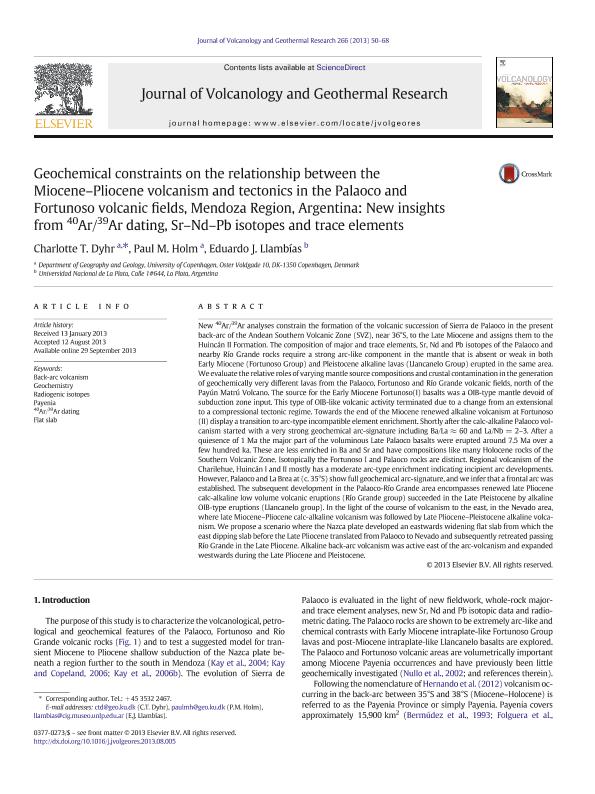Mostrar el registro sencillo del ítem
dc.contributor.author
Dyhr, Charlotte T.
dc.contributor.author
Holm, Paul M.
dc.contributor.author
Llambias, Eduardo Jorge

dc.date.available
2017-09-11T20:43:53Z
dc.date.issued
2013-10-01
dc.identifier.citation
Dyhr, Charlotte T.; Holm, Paul M.; Llambias, Eduardo Jorge; Geochemical constraints on the relationship between the Miocene–Pliocene volcanism and tectonics in the Palaoco and Fortunoso volcanic fields, Mendoza Region, Argentina: New insights from 40Ar/39Ar dating, Sr–Nd–Pb isotopes and trace elements; Elsevier Science; Journal of Volcanology and Geothermal Research; 266; 1-10-2013; 50-68
dc.identifier.issn
0377-0273
dc.identifier.uri
http://hdl.handle.net/11336/23943
dc.description.abstract
New 40Ar/39Ar analyses constrain the formation of the volcanic succession of Sierra de Palaoco in the presentback-arc of the Andean Southern Volcanic Zone (SVZ), near 36°S, to the Late Miocene and assigns them to theHuincán II Formation. The composition of major and trace elements, Sr, Nd and Pb isotopes of the Palaoco andnearby Río Grande rocks require a strong arc-like component in the mantle that is absent or weak in bothEarly Miocene (Fortunoso Group) and Pleistocene alkaline lavas (Llancanelo Group) erupted in the same area.Weevaluate the relative roles of varyingmantle source compositions and crustal contamination in the generationof geochemically very different lavas from the Palaoco, Fortunoso and Río Grande volcanic fields, north of thePayún Matrú Volcano. The source for the Early Miocene Fortunoso(I) basalts was a OIB-type mantle devoid ofsubduction zone input. This type of OIB-like volcanic activity terminated due to a change from an extensionalto a compressional tectonic regime. Towards the end of the Miocene renewed alkaline volcanism at Fortunoso(II) display a transition to arc-type incompatible element enrichment. Shortly after the calc-alkaline Palaoco volcanismstarted with a very strong geochemical arc-signature including Ba/La ≈ 60 and La/Nb = 2?3. After aquiesence of 1 Ma the major part of the voluminous Late Palaoco basalts were erupted around 7.5 Ma over afew hundred ka. These are less enriched in Ba and Sr and have compositions like many Holocene rocks of theSouthern Volcanic Zone. Isotopically the Fortunoso I and Palaoco rocks are distinct. Regional volcanism of theCharilehue, Huincán I and II mostly has a moderate arc-type enrichment indicating incipient arc developments.However, Palaoco and La Brea at (c. 35°S) showfull geochemical arc-signature, andwe infer that a frontal arcwasestablished. The subsequent development in the Palaoco-Río Grande area encompasses renewed late Pliocenecalc-alkaline low volume volcanic eruptions (Río Grande group) succeeded in the Late Pleistocene by alkalineOIB-type eruptions (Llancanelo group). In the light of the course of volcanism to the east, in the Nevado area,where late Miocene?Pliocene calc-alkaline volcanism was followed by Late Pliocene?Pleistocene alkaline volcanism.We propose a scenario where the Nazca plate developed an eastwards widening flat slab from which theeast dipping slab before the Late Pliocene translated from Palaoco to Nevado and subsequently retreated passingRío Grande in the Late Pliocene. Alkaline back-arc volcanism was active east of the arc-volcanism and expandedwestwards during the Late Pliocene and Pleistocene.
dc.format
application/pdf
dc.language.iso
eng
dc.publisher
Elsevier Science

dc.rights
info:eu-repo/semantics/openAccess
dc.rights.uri
https://creativecommons.org/licenses/by-nc-sa/2.5/ar/
dc.subject
Back-Arc Volcanism
dc.subject
Geochemistry
dc.subject
Radiogenic Isotopes
dc.subject
Payenia
dc.subject
40ar/39ar Dating
dc.subject
Flat Slab
dc.subject.classification
Oceanografía, Hidrología, Recursos Hídricos

dc.subject.classification
Ciencias de la Tierra y relacionadas con el Medio Ambiente

dc.subject.classification
CIENCIAS NATURALES Y EXACTAS

dc.title
Geochemical constraints on the relationship between the Miocene–Pliocene volcanism and tectonics in the Palaoco and Fortunoso volcanic fields, Mendoza Region, Argentina: New insights from 40Ar/39Ar dating, Sr–Nd–Pb isotopes and trace elements
dc.type
info:eu-repo/semantics/article
dc.type
info:ar-repo/semantics/artículo
dc.type
info:eu-repo/semantics/publishedVersion
dc.date.updated
2017-09-06T17:19:36Z
dc.journal.volume
266
dc.journal.pagination
50-68
dc.journal.pais
Países Bajos

dc.journal.ciudad
Amsterdam
dc.description.fil
Fil: Dyhr, Charlotte T.. Universidad de Copenhagen; Dinamarca
dc.description.fil
Fil: Holm, Paul M.. Universidad de Copenhagen; Dinamarca
dc.description.fil
Fil: Llambias, Eduardo Jorge. Universidad Nacional de La Plata; Argentina. Consejo Nacional de Investigaciones Científicas y Técnicas; Argentina
dc.journal.title
Journal of Volcanology and Geothermal Research

dc.relation.alternativeid
info:eu-repo/semantics/altIdentifier/url/http://www.sciencedirect.com/science/article/pii/S0377027313002394
dc.relation.alternativeid
info:eu-repo/semantics/altIdentifier/doi/http://dx.doi.org/10.1016/j.jvolgeores.2013.08.005
Archivos asociados
